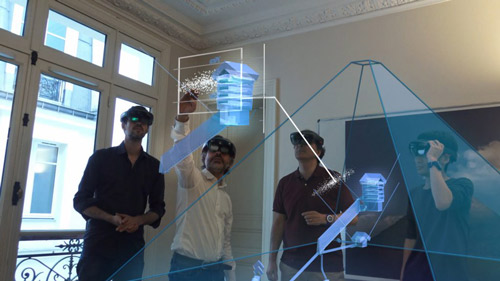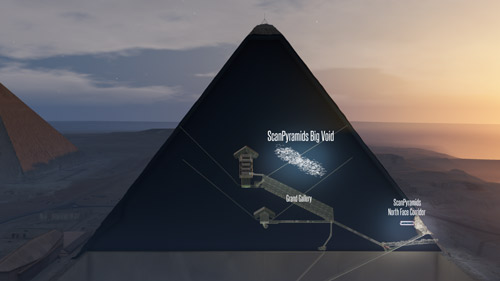Using AI to control energy for indoor agriculture
30 September 2024
Published online 2 November 2017
First major Khufu structure found in centuries as particle physics meets ancient history.

Cutting-edge visualisation techniques borrowed from space science have exposed a huge space at the heart of the Great Pyramid, built around 2560BCE as a tomb for the pharaoh king Khufu. The cavern is so large that the team investigating it have compared it to the famous Grand Gallery, one of the three known chambers in the pyramid, above which it sits.
"What we are sure about is that this big void is there. That it is impressive."
“No major structure has been found inside the Khufu pyramid since the Middle Ages when Caliph al Ma’moun discovered the main internal structure” says Mehdi Tayoubi, president of the French Heritage Innovation Preservation (HIP) Institute, and lead strategist behind the non-invasive approach. The last discovery within the pyramid was in the 1800’s.
The big void, as Tayoubi calls it, is at least 30 metres long with the same cross section as the grand gallery, which is eight metres high. It could be horizontal or inclined, and it could be composed of one or more structures that support it.
“What we are sure about,” he says, “is that this big void is there. That it is impressive. That it was not expected from any kind of theory.”
Tayoubi’s confidence stems from the many months of experiments his teams have carried out. Three different teams with different techniques measured the movement of muons, or cosmic ray particles, as a method of scanning the Great Pyramid from the inside out.
Muons are high energy particles similar to electrons but with a much greater mass. They are produced when cosmic rays originating from outer space hit our atmosphere.
Because they are able to penetrate structures, measuring the quantity of muons, or muon flux, from a given direction gives an indication of the density of the matter in this direction. More muons signals less density, or a void, and vice versa, explains Sebastien Procureur of the Institute of Fundamental Research into the Fundamental Laws of the Universe at the French Alternative Energies and Atomic Energy Commission (CEA).
Observation of the big void was initially made by Kunihiro Morishima’s team of particle physicists from Nagoya University, Japan, who had placed specialised nuclear emulsion films in the Queen’s Chamber inside the pyramid to detect muon movement and direction.
It was subsequently confirmed with detectors set up in the same chamber by KEK, Japan’s High Energy Accelerator Research Organisation, and reconfirmed with gas detectors outside of the pyramid by Procureur.

© ScanPyramids mission
Similarly, the idea that the pyramids are a kind of ‘swiss cheese’ full of holes, does not hold, he says. If this were the case there would be a lower density average from these stones that could be observed in any given direction. But this is not what they have seen.
“We see a large density coming from a precise direction, so it is not compatible with this theory,” he says
The findings, published in Nature today, is part of the ScanPyramid project, a programme launched under the auspices of the Egyptian Ministry of Antiquities and designed and run jointly by HIP and the Faculty of Engineering in Cairo.
It follows on from the discovery of a cavity behind the chevrons on the northeast face of the great pyramid in October last year and the Bent Pyramid in Dahshour in April 2016.
While the team have had the technology to penetrate the thick walls and discover the hidden structure beneath, they still have no answer to the question about the purpose the great cavern may have served.
"Detecting new voids in the pyramid could help us to find out the different systems of construction of the pyramid," says Hany Helal from the faculty of engineering, Cairo University, and former Egyptian minister of higher education and state minister for scientific research. “We have to work with Egyptologists and specialists to understand better the meaning of [the] data."
The hope among the team is that the discovery will encourage a new generation of Egyptologists to look at the Old Kingdom, and that more scientists can undertake this kind of exploration. The team will continue working in Egypt and is ready to apply the techniques to other places in the region if requested.
doi:10.1038/nmiddleeast.2017.155
Stay connected: